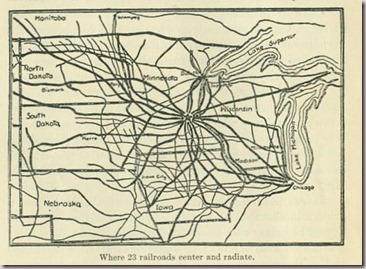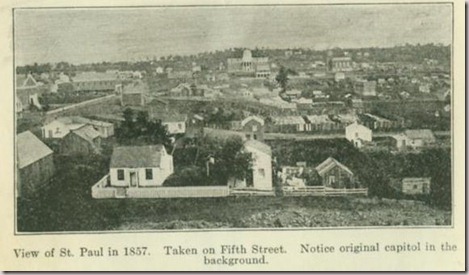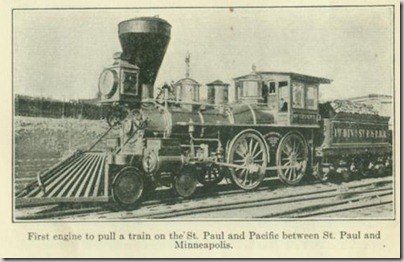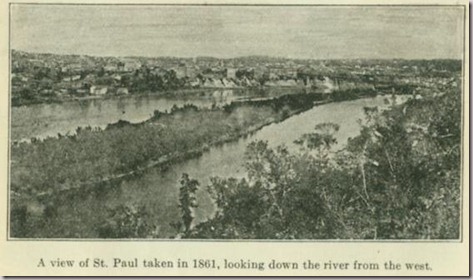
ALEXANDER RAMSEY
Alexander Ramsey was the first territorial and the second state governor of Minnesota. His biographer calls him "the first and greatest" of all governors of Minnesota. He was born in 1815 of Scotch-German parentage near Harrisburg,
Pennsylvania, and died in St. Paul in 1903. He received little more than an ordinary schooling. By trade a carpenter, he found time to prepare himself for teaching, and, while he was a teacher, he studied law.
From young manhood on he strove to become a man of affairs. His legal studies enabled him to enter Pennsylvania politics and he was elected to Congress in his native state. As Representative in the Lower House, he became quite prominent. President Taylor considered him the most suitable man for territorial governor of the new territory of Minnesota. Accordingly he appointed him to that office in 1849. When Ramsey arrived in St. Paul in that same year, he found the future capital of the state a small hamlet, consisting for the most part of bark-roofed cabins. On the few irregular streets, he saw Indians strutting about in their strange native costumes. The common currency of the territorial capital consisted of cranberries and pelts and the only methods of passenger transportation were by steamboat, Red River carts, and on horseback.
Governor Ramsey and his wife, in June, 1849, occupied as their home a cottage which stood on the south side of Third Street between Robert and Jackson streets. The executive office was in the same building. It was afterwards converted into a hotel and called The New England House.
The new territorial governor was in fact but governor of that part of Minnesota lying between the Mississippi and St. Croix Rivers. Casting a longing eye upon the immense
territory west of the Father of Waters, he set about to acquire a goodly portion of it. So in 1851 he succeeded by the famous Treat}' of Traverse des Sioux (St. Peter) in obtaining from the Sioux about 25,000,000 acres. The signing of the treaty was perhaps the most picturesque event that up to that time had happened in what is now Minnesota. All the chief officials of the territory, numerous traders, speculators and editors, and all the important Sioux chiefs adorned in full tribal regalia and accompanied by thousands of painted warriors were present when the red men signed away an empire to the palefaces. Very soon an army of white settlers made a blooming garden out of the rich wilderness.
As governor of the state from 1860-63 Ramsey laid the foundation of the enormous land- grants for education, favored immigration, insisted upon strict economy in state expenditure, and organized the Minnesota regiments for service in the Civil War.
In 1863 he was elected to the United States Senate. In 1879 President Hayes made him Secretary of War.
What his home city thought of Ramsey is shown by its naming a street for him, by its giving his name to the very county in which St. Paul is located, and by its electing him Mayor in 1855. A park and a school also bear his name.

EDWARD DUFFIELD NEILL
Edward Duffield Neill was born in Philadelphia in 1823 and died in St. Paul in 1893. He was an eminent preacher, educator, and historian.
Neill was educated in the grammar school attached to the University of Pennsylvania, took two years of collegiate work at the same institution, was graduated at Amherst, and spent one year at the Andover Theological Seminary. In 1848 he was ordained a Presbyterian minister and the year following arrived in St. Paul. So eager was he for his chosen work that in a few months he succeeded in having his church building finished. This was the first Protestant Church built in St. Paul.
This church was located on Washington Street near Fourth. It was burned in 1850 and rebuilt at Third and St. Peter streets. This was the largest building in the state at that time.
Dr. Neill's residence was the first one to be erected in its vicinity, occupying the site on Summit Avenue where later the spacious home of James J. Hill was erected.
It was also the first brick residence erected in the city. To the Indians bricks were a great curiosity. They watched the building rise with wonder, and even carried off some of the bricks as souvenirs or as stones upon which to sharpen knives.
In 1851 he became the first Superintendent of Instruction of the territory of Minnesota. Two years afterwards he founded the Baldwin School and the College of St. Paul (Macalester). The House of Hope Church was organized by him in 1855 and he remained its pastor till 1859, when he resigned in order to give all his time to his duties as State Superintendent of Instruction. Neill must have been a man of forceful character and very eager for the spread and advancement of education; for, in 1858, he was made Chancellor of the University of Minnesota.
He also preached the first Thanksgiving sermon delivered in Minnesota on December 26, 1850, before a congregation composed of Baptists, Methodists, and Presbyterians In the light of subsequent events a sentence of his sermon was prophetic. He said: "The gates of the Rocky Mountains will be thrown open and the locomotive, groaning and rumbling from Oregon, will stop here with its heavy train, on its way to some other point."
In spite of the manifold work on Neill's shoulders, he put all his power and vigor in the work at hand. So we find him engaged from 1858 to 1861 in the tremendous task of building up the common schools and higher institutions of learning of the State of Minnesota. Among other schools established chiefly by his effort is the Teachers College at Winona.
When the Civil War broke out, nothing could keep him in civil life. He became Chaplain of the First Minnesota regiment. His services in this capacity must have called for meritorious mention; for, in 1861, Lincoln appointed him hospital Chaplain in Philadelphia. No doubt, it was here that he came into personal touch with the president, who certainly must have been very favorably impressed by Neill's work and personality because in 1864 Lincoln appointed him one of his private secretaries. Neill held the same office under President Johnson. During Grant's administration, he was sent to Dublin as U. S. Consul. Neill's heart, however, was in the struggling institution he had founded in St. Paul, namely, the College of St. Paul. Accordingly he returned in 1870 and began the task of building up and enlarging the college which became Macalester College. He was its first president. When he felt the burden too heavy, he relinquished his post to younger and more vigorous hands and contented himself with serving as professor of history, literature and political science, which position he held till his death.
Despite his eminent services as a preacher and educator, his favorite work was historical research. He certainly could not have had much leisure in the various responsible positions he occupied, but such as it was, he spent it in delving into historical manuscripts and studying other historical sources. Being an Easterner, he naturally devoted his younger years to historical research of Eastern history, especially that of Virginia and Maryland; but, when he came to St. Paul and saw a state in the making, nothing could prevent him from making a profound study of his new home. So we find him publishing a History of Minnesota in 1858 and delivering lectures on historical subjects bearing upon Minnesota. Among them, those of special interest to students in St. Paul are:
The French Voyageurs in Minnesota during the Seventeenth Century.
Life and Writings of Hennepin.
History of Gibways (Chippewas).
Occurrences in and around Fort Snelling from 1819 to 1830.
 JAMES JEROME HILL
JAMES JEROME HILLA name that is known all over the world is that of James Jerome Hill, the empire builder. It is inseparably associated with the development of St. Paul and the Northwest.
Mr. Hill was born on a farm in Ontario, Canada, in 1838, of Scotch-Irish parentage. His early education was obtained in a district school and a local academy. It was his good fortune, however, to come under the guidance of William Wetherald, an eminent teacher, who helped to fit him for his future career. When hut fourteen years old, on account of the death of his father, he was compelled to leave school to work in a village store in order to help in supporting the family.
He read substantial books intensively. He studied the primitive methods of transportation on the Oriental rivers. His fancy became inflamed, and young Hill began to dream of improving the river transportation system of the near East. His resolution led him to seek the Pacific coast. The most natural gateway, even in 1856, was St. Paul. He, therefore, worked his way to St. Paul by Chicago and the Mississippi River, arriving here in July, 1856.
The last party to the Red River Valley had just left. Although stranded and without a job, he did not bemoan his fate. He became a clerk for J. W. Bass & Co., agents for the Dubuque and St. Paul Packet Company, with whom he served so well that he rose to better and more profitable positions. These years were a period of growth. Alert, gifted with an extraordinary power of observation and a marvelous memory, he gained a masterly knowledge of the prevailing transportation system. He now read standard works of a technical character which enlarged and clarified his understanding of the subject.
Industrious and upright, he saved his money and soon became one of the leading citizens of St. Paul. In 1865, he became the local manager of the Northwest Packet Company. His enterprise prospered, and he become a thriving, public-spirited business man. His wisdom and energy had won.
Relieving in the future of the Northwest and of St. Paul as the natural distributing center for this immense region, Hill became what we call "a booster." He put a warehouse on the levee and started a general commission and forwarding business. Soon afterwards, he contracted with the St. Paul and Pacific Railway Company to handle its local freight. Foreseeing the possibilities of railroad traffic, he traveled to the Red River Valley and Winnipeg, where much of St. Paul business originated. He had no doubt of the great future of this region and awaited an opportune time for entering the railway transportation business.
In 1873, the St. Paul and Pacific Railway Company became bankrupt. Hill took advantage of this situation to interest some prominent Canadian financiers who realized the impossibility of building a railroad from Winnipeg west through Canada to the Pacific, and who were, therefore, willing to join with Hill in constructing a line through the United States. Together they bought the defaulted bonds of the bankrupt road. In 1870, the St. Paul, Minneapolis and Manitoba Railway Company was eventually organized.
This company built branches in all directions through Minnesota and North Dakota, and subsequently, reached the Pacific coast in 1893. The new line from St. Paul to Puget Sound and Portland was called the Great Northern.
Mr. Hill had good reason to feel proud of his accomplishment as he achieved this gigantic success without any help from the Federal Government.
Mr. Hill was a man of ability, vision, courage, and consequently, of strength of personal character. Work is a pleasure to him. He made no excuse for himself. What he undertook, he finished. What he promised, he kept. And what lie demanded of himself, he demanded of others.
He had an appreciation of the beet in art and had a splendid collection of its treasures. He was a student of the world's best literature. As a consequence, he built and donated to the city a magnificent building and library which bears his name.
To many of our public institutions he was a generous giver. Among these were the colleges and seminaries. From one of the colleges he received the degree of Doctor of Laws.
A life is noteworthy that accomplishes so much. A character that is unselfish and that contributes so much to the social need is noble.

CUSHMAN KELLOGG DAVIS
Cushman Kellogg Davis was born in the state of New York in 1838 and died in 1900 in St. Paul. He was one of the most talented men that ever lived in St. Paul. Davis was nationally known as a statesman, writer on literary subjects, and as an orator.
His parents moved to Waukesha, Wis., where he spent his childhood. In 1857 he graduated from the University of Michigan. After completing a thorough course in law, he practiced in Waukesha. Joining the army in the Civil War,
he was rapidly promoted and became Adjutant General on the staff of General Gorman. As he contracted typhoid fever in the South, Davis was compelled to leave the army in 1864. Soon afterwards, in 1865, he started a law office in St. Paul. In 1867 he was elected a member of the Legislature. His forceful character and distinguished work as a lawyer soon brought him national recognition, for, in 1868, he was appointed United States district attorney for Minnesota. From 1874 to 1876 he was Governor of Minnesota. His chief merit as executive to the state was the establishment of a railway commission, which was to protect the people against excessive rates.
After his term of governor had expired he devoted his time to private practice. In 1887 he was elected United States Senator. In this higher position he distinguished himself so greatly that he was made chairman of the Committee on Pensions, and later chairman of the Committee on Foreign Relations. As chairman of the Pensions Committee, he was instrumental in having a pension law enacted that put an end to excessive pensions but that was just and fair to the veterans of the Civil War. During his chairmanship of Foreign Affairs the Spanish-American war broke out. When peace was made, President McKinley appointed him as one of the Peace Commissioners. It was largely due to his influence that the United States insisted upon the relinquishment of the Philippine Islands by Spain. During his whole service as a public man, Davis was a vigorous and clear expounder of the Monroe Doctrine. When he died in 1900, both the United States Senate and the House of Representatives paid heartfelt and eloquent tribute to his services, character, and memory.
Though Davis did good work for St. Paul and Minnesota, he was more of a national character than a mere local man of eminence and standing. When the army of Tennessee met at Lake Minnetonka, in 1884, General Grant asked Davis to deliver the principal address. The oration delivered on this occasion was heard by Grant, Sherman, and Sheridan. It was, perhaps, the most eloquent address ever given in this state. Almost equally brilliant was his famous oration on the battlefield of Gettysburg, in which he paid tribute to what Minnesota did in the Civil War, and his address given in St. Paul at the laying of the corner-stone of the new capitol in 1898 is still remembered as the most brilliant speech ever delivered in St. Paul.
As a writer in the field of literature, Davis attracted general attention. His lectures on Modern Feudalism, Hamlet, The Law in Shakespeare, and Madame Roland are notable examples of his ability.
In view of his eminent public service, his firm stand on the side of right without regard to persons and interests, and his literary and oratorical abilities, it must be conceded that he was one of the most versatile and efficient men that has represented this city and state.

John Ireland was born in 1838 in County Kilkenny, Ireland, and died in St. Paul in 1918. When eleven years old, he came with his parents to St. Paul, where he at tended the Cathedral School. From 1853 to 1801 he was in France studying theology. Returning to St. Paul, he was ordained priest and very soon afterwards volunteered his services as Chaplain of the Fifth Minnesota Regiment. Afterwards he became rector of the St. Paul Cathedral. For a short time he served as secretary to Bishop Grace of St. Paul, who sent him to Rome in 1870 as his representative at the famous Vatican Council. In 1875 he was appointed Coadjutor Bishop of St. Paul, and, on Bishop Grace's resignation in 1884, John Ireland became Bishop of St. Paul. In 1887 Bishop Ireland and his friend Bishop Keane went to Rome to consult with Leo XIII with reference to the foundation of a Catholic university in Washington, D. C. A short time afterwards he was made the first Archbishop of St. Paul. The St. Paul Catholic dignitary was a commanding personality in various important educational, economic, social, and political movements.
Perhaps the most important influence of the St. Paul archbishop was his outspoken stand for patriotism. Never did he miss an opportunity to proclaim by word and deed the obligations of patriotism. He was always in touch with men high in the national administration, being on a particularly friendly footing with President McKinley, who sent him to Europe in order to explain the American attitude as to the problems resulting from the Spanish-American war.
St. Paul was very dear to the prelate. He took an active interest in all questions and problems affecting the welfare of the city. His last tribute to St. Paul was the erection of the Cathedral, which magnificent structure on the brow of Summit Avenue is one of the glories of the city.
The archbishop was a pronounced advocate of temperance, so that his influence on this subject was felt not only in his church but as a force in politics.
Having seen much of the development of this section and of the whole Northwest, he had great faith in the progress that would follow. On the occasion of the celebration of the bicentennial of the discovery of St. Anthony Falls he gave a memorable address.
Coming to St. Paul when he was but a young man he saw not only the development of the city, but he was a very integral factor in its life. While he fostered the educational and religious institutions of his church, he was equally interested in the promotion of the growth and welfare of the whole city. His activity' and influence were the result of great strength of character and the promptings of high ideals.
QUESTIONS
How did Governor Ramsey happen to come to St. Paul?
What kind of a town did he find St. Paul?
What did he do for the city and the state?
Has anything been done in his memory?
Was he a good man to have in office? Why?
Where did Mr. Neill serve in political life?
How was he connected with education?
What church did he build?
Why do you suppose President Lincoln liked him?
What special natural abilities did Mr. Hill have?
What personal qualities helped him to success?
What benefit are men like Mr. Hill to the city?
What offices did Mr. Davis hold?
What abilities did he have besides statesmanship?
As a senator what prominence did he attain?
Can you name some of his notable addresses?
What ran you tell of Bishop Ireland's early life?
What kind of American citizen was he?
On what special mission was he sent to Europe?
What building is a monument to his memory?




